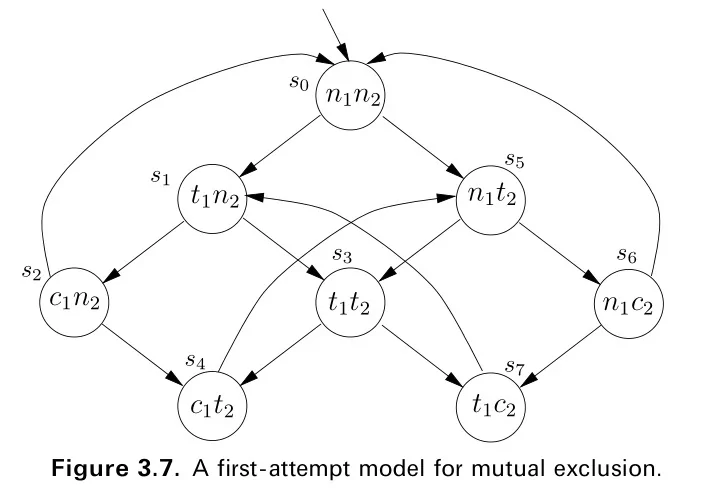

s 0 n 1 n 2 s 5 s 1 n 1 t 2 t 1 n 2 s 3 s 6 s 2 c 1 n 2 t 1 t 2 n 1 c 2 s 4 s 7 t 1 c 2 c 1 t 2 Figure 3.7. A first-attempt model for mutual exclusion.
s 0 n 1 n 2 s 5 s 1 n 1 t 2 t 1 n 2 s 3 s 9 s 6 s 2 c 1 n 2 t 1 t 2 n 1 c 2 t 1 t 2 s 4 s 7 t 1 c 2 c 1 t 2 Figure 3.8. A second-attempt model for mutual exclusion. There are now two states representing t 1 t 2 , namely s 3 and s 9 .
MODULE main VAR request : boolean; status : {ready,busy}; ASSIGN init(status) := ready; next(status) := case request : busy; 1 : {ready,busy}; esac; LTLSPEC G(request -> F status=busy)
req req ready busy ¬ req ¬ req ready busy
MODULE main VAR pr1: process prc(pr2.st, turn, 0); pr2: process prc(pr1.st, turn, 1); turn: boolean; ASSIGN init(turn) := 0; -- safety LTLSPEC G!((pr1.st = c) & (pr2.st = c)) -- liveness LTLSPEC G((pr1.st = t) -> F (pr1.st = c)) LTLSPEC G((pr2.st = t) -> F (pr2.st = c)) -- ‘negation’ of strict sequencing (desired to be false) LTLSPEC G(pr1.st=c -> ( G pr1.st=c | (pr1.st=c U (!pr1.st=c & G !pr1.st=c | ((!pr1.st=c) U pr2.st=c))))) MODULE prc(other-st, turn, myturn) VAR st: { n, t, c } ; ASSIGN init(st) := n; next(st) := case (st = n) : { t,n } ; (st = t) & (other-st = n) : c; (st = t) & (other-st = t) & (turn = myturn): c; : { c,n } ; (st = c) 1 : st; esac; next(turn) := case turn = myturn & st = c : !turn; 1 : turn; esac; FAIRNESS running FAIRNESS !(st = c) Figure 3.10. SMV code for mutual exclusion. Because W is not sup- ported by SMV, we had to make use of equivalence (3.3) to write the no-strict-sequencing formula as an equivalent but longer formula in- volving U.
2 tn1 2 1 cn1 1 1 1 1,2 2 nn1 tt1 1,2 ct1 2 2 1,2 1,2 1 tc1 1 nt1 2 2 1 1 2 nc1 1,2 1,2 cn0 1 2 2 1 1 tn0 2 ct0 1,2 2 1,2 tc0 1 1 1,2 nn0 tt0 1,2 1 2 2 nc0 2 2 1 nt0 1 Figure 3.11. The transition system corresponding to the SMV code in Figure 3.10. The labels on the transitions denote the process which makes the move. The label 1 , 2 means that either process could make that move.
MODULE main VAR ferryman : boolean; goat : boolean; cabbage : boolean; wolf : boolean; carry : { g,c,w,0 } ; ASSIGN init(ferryman) := 0; init(goat) := 0; init(cabbage) := 0; init(wolf) := 0; init(carry) := 0; next(ferryman) := 0,1; next(carry) := case ferryman=goat : g; 1 : 0; esac union case ferryman=cabbage : c; 1 : 0; esac union case ferryman=wolf : w; 1 : 0; esac union 0; next(goat) := case ferryman=goat & next(carry)=g : next(ferryman); 1 : goat; esac; next(cabbage) := case ferryman=cabbage & next(carry)=c : next(ferryman); 1 : cabbage; esac; next(wolf) := case ferryman=wolf & next(carry)=w : next(ferryman); 1 : wolf; esac; LTLSPEC !(( (goat=cabbage | goat=wolf) -> goat=ferryman) U (cabbage & goat & wolf & ferryman)) Figure 3.12. NuSMV code for the ferryman planning problem.
Recommend
More recommend